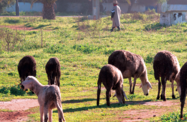Morocco: Positive outlook for agriculture
 En Français
En Français
Improved weather conditions in Morocco have boosted the prospects of a strong harvest for the 2012/13 season which should, in turn, play a part in driving forward the second phase of the government’s agricultural development strategy, Plan Maroc Vert (PMV).
The favourable outlook for the agricultural sector is particularly welcome, coming on the back of a difficult 2012 when unseasonably cold weather early in the year, followed later by weeks of drought, took its toll on a number of key crops.
The national cereals harvest is now forecast to reach a record 9.7m tonnes from a low of 5.1m in 2011/12, helping to boost agriculture’s contribution to the economy in line with PMV goals.
In the near-term, improved agricultural output in 2012/13 will generate key export revenues and reduce a reliance on wheat imports. Last year’s adverse weather conditions weighed heavily on wheat crops in particular, as well as fruit and vegetable harvests.
The performance of the agriculture sector – which accounted for about 13% of GDP in 2011 – can have a significant impact on the overall economy. Lower-than-average production last year helped to contribute to a decline in GDP growth, which fell from 5% in 2011 to 3.2% in 2012, according to the IMF. The international lender estimates this figure will rise to 4.5% this year, although government officials, expecting a strong harvest, have projected a more aggressive 5.5%.
Indeed, weather conditions have improved significantly. The minister of agriculture, Aziz Akhannouch, told local media last month that accumulated rainfall reached 434 mm between January and mid-April 2013, up 91% year-on-year and 27% higher than average yearly levels. The minister added that Morocco’s dams were filled to 92% capacity in mid-April, up from 69% the prior year.
The PMV, which was launched in 2008, is also starting to yield results. The programme is one of a number of strategic projects that Morocco’s government has launched over the past decade to target improved efficiency and output in key sectors. Alongside agriculture, tourism and manufacturing exports have also been the focus of regulatory overhauls, ancillary support and increased public investment. In an interview given to the local media, Akhannouch said Morocco’s cultivated land surface increased by 11% between 2008 and 2012. Overall agricultural output rose by an estimated 43%, he added, while sector GDP jumped 32% in the same period. The minister said 333,000 ha now benefitted from localised irrigation systems, up 79% since 2007.
The Ministry of Agriculture estimates that, since the launch of the PMV, some Dh53bn (€4.77bn) has been invested through the programme, of which Dh12.3bn (€1.1bn) has been mobilised by bilateral and multilateral partners. An estimated Dh5.3bn (€475.9m) has come in the form of grants, and the remainder through loans.
Lenders include the World Bank, which announced in March it had signed a second financing agreement with Morocco. Under the terms of the agreement, the international financial institution will provide a $203m Development Policy Loan to support programmes focusing on modernisation techniques. These funds are also expected to shore up efforts to streamline domestic wholesale markets and encourage innovation and agricultural research.
The Ministry of Agriculture has signed a handful of bilateral agreements for technical and financial support. These included two conventions agreed with Germany at the eighth annual Salon International de l’Agriculture du Maroc fair, under which Morocco will receive technical support for the development of value-added products, such as cheese, as well as assistance in marketing abroad.
In April the government signed a deal with Belgium, which has committed Dh191m (€17.5m) to support export-oriented agricultural activities. The funds will be used to develop saffron and date palm projects in the Souss-Massa-Draâ region.
While much remains to be done in terms of rolling out these announced programmes as well as tapping into new sources of investment, the progress made in the PMV’s first five years, together with a positive outlook for 2013, bodes well for Moroccan agriculture in the near and medium term.



